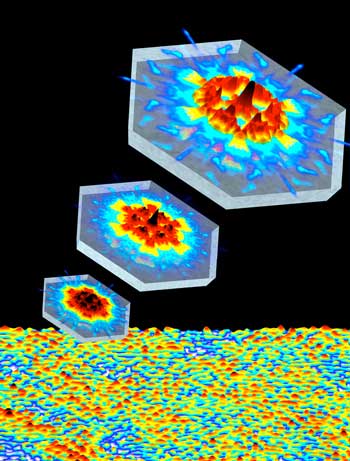| Posted: Jan 12, 2018 |
Quantum information finds its edge
(Nanowerk News) Harnessing quantum physics for problem solving could help to make quantum computing a practical reality. A theoretical study by two RIKEN scientists has identified the potential and limitations of one possible way to realize this that involves an exciting class of materials known as topological insulators (Physical Review Letters, "Disorder-induced dephasing in backscattering-free quantum transport").
|
 |
| Edge states in topological insulators are immune to backscattering at defects, which potentially makes them a useful platform for quantum information processing. (Image: Dr A. Yazdani/Science Photo Library)
|
|
Topological insulators conduct electric currents on their edges or surfaces, but are insulating elsewhere. These conducting states are immune to defects on the edge: the current simply flows around them, unlike in conventional conductors where it scatters backwards.
|
|
One possible application for topological insulators is in quantum information processing. This technology uses physical systems that exhibit quantum properties (atoms or photons, for example) to solve problems that are intractable with conventional computers.
|
|
The main challenge to developing future quantum electronic devices is that most quantum states are very delicate, being easily destroyed by perturbations or interactions with their environment. The robustness of the electronic states in a topological insulator offers a potential solution, since quantum information could be encoded in sequences propagating at the surfaces.
|
|
Clemens Gneiting and Franco Nori from the RIKEN Quantum Condensed Matter Research Group theoretically investigated the full effect of defects on a quantum edge state in a topological insulator.
|
|
While the transport of edge states is insensitive to defects, defects can deform another defining feature of a quantum state—its phase. This poses a potential obstacle to their successful deployment as carriers of quantum information.
|
|
“Our goal was to understand the reliability of potential quantum devices,” says Gneiting. “We can assess all aspects of the impact of disorder using a comprehensive, time-resolved and statistically robust description of the perturbed edge state propagation.”
|
|
Gneiting and Nori achieved this by applying a recently developed method for theoretically simulating disordered quantum systems using the so-called Lindblad master equations. They were able to quantify the disorder-induced dephasing and how this relates to the properties of topological insulators. The pair showed that the dephasing has a limit, unlike the unlimited dephasing encountered in ordinary materials.
|
|
The same theoretical approach could also be useful for assessing the influence of disorder in many other systems, including others characterized by lossless propagation, such as charge carriers in graphene or light in a non-uniform medium.
|
|
“Uncontrolled disturbances haunt virtually all quantum technologies, since these typically demand extreme precision,” explains Gneiting. “We thus believe that other candidate systems may also benefit from a detailed and comprehensive analysis of the disorder impact.”
|

